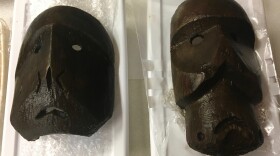The community of Quinhagak is currently awaiting the return shipment of 60,000 Yup’ik artifacts in time for its August 11 museum opening. As the clock ticks to save fragile items unearthed by melting permafrost at the Nunalleq archaeological dig site in Quinhagak, community members and investigators hurriedly prepare to house the largest collection of Yup’ik artifacts in the world.
“We were hoping that the artifacts will be back by then, and then we can celebrate the return," said archeologist Rick Knecht, dig site manager of Nunalleq.
"It is a tough task, but I, for the sake of our community want this museum to be here. These artifacts were found here on our land, they will be here at Quinhagak and Qanirtuuq [Village Native Corporation] will be the owner," said Qanirtuuq President Warren Jones.
Items started appearing on the shore near Quinhagak back in 2009, when Jones and community members discovered them in exposed tundra.
In the thawing permafrost, they saw items from hundreds of years ago, dating date back to the Bow and Arrow wars of the 1670’s, as remembered still today in Yup'ik oral history. Jones decided to contact archeologist Rick Knecht to investigate what they had there, and that evolved into one of the largest excavations of organic material artifacts in the world.
Under the Qanirtuuq’s direction, with Knecht, and funding support from the University of Aberdeen, Scotland, where Knecht teaches, over the last decade the team has unearthed 60,000 items and counting. The items were initially sent to Aberdeen, where they could be cleaned and preserved in the University's lab facilities. But last summer Qanirtuuq converted a former elementary school into a laboratory to preserve artifacts onsite, and soon, the lab will also serve as a cultural center and museum.
The opening date is set for August 11.
Even if the artifacts don’t make it to Quinhagak by then, there will still be workshops led by community members, archeologists, visiting artists, and carvers. There will also be a celebration.
Qanirtuuq plans to meet with visiting museum staffers from around the state to talk about possible future support and collaboration.




